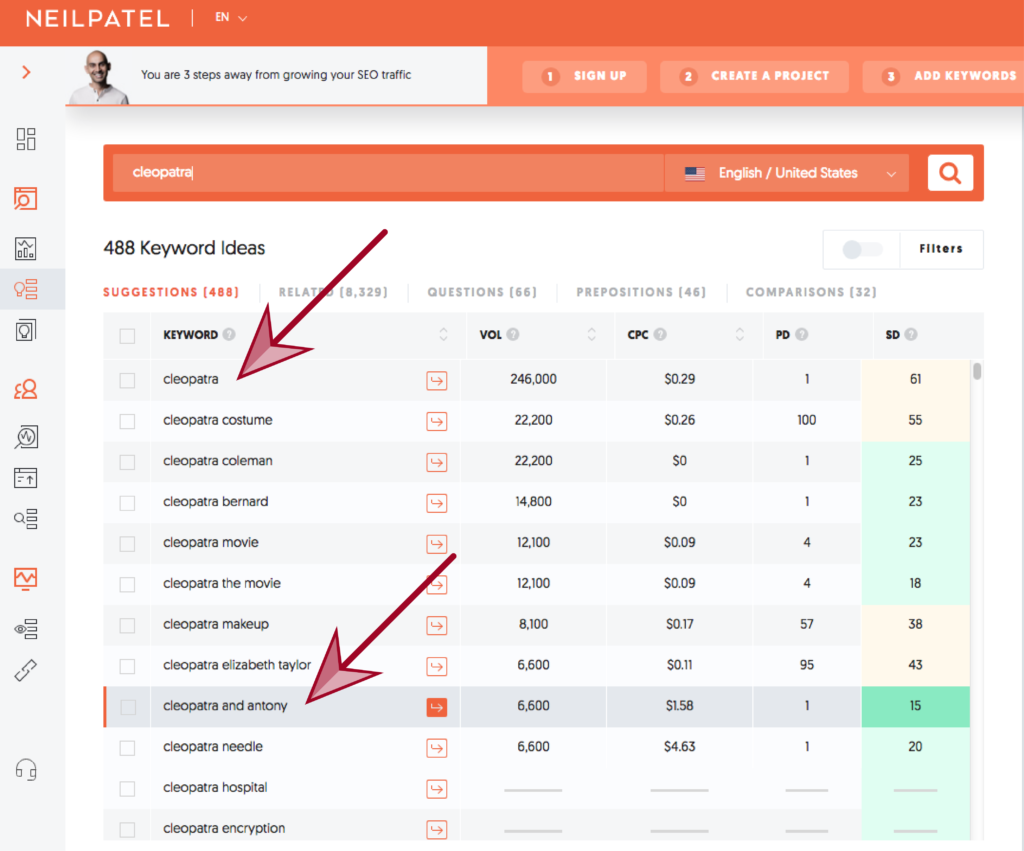I bet when you decided to start a history blog you didn’t leap up in the air with excitement about keywords research for each post. In fact, you may not have considered keywords research part of history blogging at all, and as you’re reading this be in the category of bloggers who either don’t know what it is at all or kinda do but don’t really get it.
If any of these sounds like you then read on. Keywords research is really important to bring visitors to your blog, but my goodness it can be overwhelming too.
Here, I will save you stacks of research time and explain what keywords are, the seven mistakes you may be making and the action you can take right now (even on older posts) to fix them.
Right, So What are Keywords?
Choosing and using keywords is all part of Search Engine Optimisation or SEO.
“SEO is the practice of increasing the number of people visiting your history blog organically or an unpaid way”
Elizabeth Hill-Scott
For example, imagine you’ve written a blog post about the life of Cleopatra and used her name as your keyword.
If you typed “Cleopatra” into Google it would give you an index or list of web pages and images about her – that’s the SE part.

Now, you want to be on that list right? Heck, you want to be top of that list, because higher visibility in searches means more visitors. So, the O, optimization, part is making sure you’ve made it as easy as possible for the spiders. These spiders are crawling around the web looking to index pages about Cleopatra into a cute list and you want them to find your webpage, your Cleopatra blog post.
There are various ways to improve your SEO like adding internal links in your posts, getting backlinks into your blog and making your posts shareable but today we’re going to focus on keywords.
The 7 Keywords Research Mistakes that May be Holding Back Your History Blog
Mistake One: Not choosing long-tail keywords
Aside from not actually doing any keywords research, the first mistake is choosing a word or phrase that is just too big and broad.
Using the Cleopatra example above there were 62,400,000 search results in Google. If you choose her name as your keyword your webpage and your efforts will likely get lost.
A long-tailed keyword offers a little refinement and specificity. Examples include:
- Cleopatra movie
- Cleopatra death
- Cleopatra’s rise to power
- Cleopatra husband mark anthony
Also, the consensus seems to be that search engines are sophisticated enough to not hinder you if you need to use an apostrophe.
Action: Explore a list of potential long-tailed keywords for your next blog post and keep the reader or web searcher in mind. Put yourself in their shoes. How would they type a phrase into Google?
Mistake Two: Writing before your keywords research
Now you know you need a long-tailed keyword you need to build your writing and ideas around it.
Don’t write and proofread your post, brainstorm an amazing title and then decide on your keyword. Why? Because you will only have to unpick that post to make sure your keyword can look like a natural part of your writing. You may also find what you’ve written about doesn’t have an obvious stand-out keyword you can use and you need to put together a bizarre phrase or worse a phrase people aren’t even searching for (see mistake three)
I totally understand this may feel like blunting the creative process (and your enjoyment) with techy blog stuff but the alternative is limiting the potential for people to find and read your blog post.
Mistake Three: Not judging the competition against your monthly traffic
According to techjury.net over 4.4 million blog posts were published in March 2019. That’s a lot of posts and a lot of keywords competition. As I’ve explained, unless you have thousands of monthly visitors to your blog, focusing on the big keywords is a mistake and you need to explore long-tail keywords. However, once you have a list of long-tailed keywords you still need to test the competition within that phrase in searches.
The best tool I’ve found to explore keywords is Ubersuggest but there are others. Neil Patel, the creator of Ubersuggest, is generally accepted as an SEO guru. His tool allows you to choose the right long-tailed keyword to suit your monthly traffic rates.
The screenshot below shows you a search for the phrase ‘Cleopatra’. You’ll notice her name alone generates 246,000 searches per month. Also, if you look at the right-hand column it is yellow. This indicates a medium SD or Search Engine Difficulty rating. But, if you cast your eyes down to the row in grey, the phrase ‘Cleopatra and Anthony’ has only 6,600 and a green or easy search engine rating.
At 6,600 monthly searches, it is still a search phrase people are using and by correlation, a topic people are interested in.
Using ‘Cleopatra and Anthony’ as your keyword phrase makes it a much easier task for your blog and is a keyword you can build a blog post around.

Mistake Four: Not placing your keywords in the right places
So, you’ve now decided to write a blog post using the keyword long-tailed phrase ‘Cleopatra and Anthony’ – so where do you put it? The mistake people make most is not enough places. Here’s where you need to add it:
- Your title: “Were Cleopatra and Anthony really in love or was it just power politics?”
- Your blog post url www.smarthistoryblogging/cleopatra-and-anthony
- Your first paragraph
- Your sub-headings (not all)
- Within the body of your blog post
- The title of an image you upload
- Your ‘snippet’ – the few lines you see underneath a search title
But make sure you’re not doing mistake number five…
Mistake Five: Stuffing your keywords everywhere
Absolutely focus on your keyword but not at the expense of unnatural writing or looking spammy. For example:
“Today’s blog post is about Cleopatra and Anthony because Cleopatra and Anthony are my favourite historical figures. So let’s get started learning about Cleopatra and Anthony. Ready?”
Readers, like you and I, are human beings who want to read an interesting history blog. Yes, us bloggers have to do all this techie, behind the scenes stuff but your reader shouldn’t be aware of any of it. You can spot keyword stuffing a mile off and it may stop readers looking around your site, subscribing to your list or getting in touch ever again.
Another factor for good SEO is good content. Google wants to recommend quality content so people use their search engine and no others. They don’t want to promote spammy stuff. And, the whizzy search engines know to spot keyword stuffing. So, it’s just not worth it to do because they will not rank you if they think you’re producing naff content.
Mistake Six: Not using tools (like these beauties) to help you get keywords research right.
As stated, Ubersuggest is a very useful keyword search tool. There is also:
- Keywords Everywhere – paid but results activated immediately through a chrome extension.
- Soovle – takes keyword searches from multiple sources
- Jaaxy
- Ahrefs Keywords Explorer
- Google Search Console
- Google Keyword Planner – information straight from Google
- KeywordTool.io
- Moz Keyword Explorer
If you’re looking to spark ideas you can also try Google Trends which tells you the hot searches of the minute (or probably second)
The other type of tool you can use is an SEO optimizer within your website. So, I use the free version of Yoast, a plugin for WordPress.
Yoast gives you a rundown of the readability of your blog post and an SEO analysis using a red, orange and green face. You work your way through the list and make sure you only have the green smiley face at the end. Yoast will tell you if your keyword doesn’t appear enough or too much! Or, if your keyword needs to appear in more headings or isn’t far enough up in your snippet text. Good right?
Mistake Seven: Forgetting Pinterest is a search engine so keywords research applies
Pinterest, and for that matter Youtube, is not social media, they are search engines. This is a whole other blog post, but if you pin directly from your blog you need to think about keywords here too. This applies to the title and description of each pin as well as the file name of the image you use.
Doing a Google image search using the keyword Cleopatra (for the last time I promise : ) brings up images pinned onto Pinterest. Searching images, not pages, could be an alternative way people find your blog post too. So, keywords apply to your Pinterest strategy too.
Summary of the actions you can take right now…
- Think about your next blog post idea and sketch out some long-tailed keywords around that topic
- Use a tool to research your list of keywords. Are they the right fit and size for your blog’s monthly traffic?
- Decide on a long-tailed keyword and write a blog post based around it
- Install Yoast into WordPress (if you have it) and see if you’re doing everything possible to get a green smiley face
- And, if you have time see if you can improve older popular posts but don’t change the URL (web address) as it will just create a broken link.
Conclusion
If you implement a keywords strategy it may take a few months to make a difference. There’s no tool or quick shortcode widget to shoot you up search engine’s rankings. But, this is completely normal (remember the 4.4 million posts a month statistic!)
With everything history bloggers have to do, I hope I’ve shown a timesaving way to approach keywords research. I made a lot of mistakes when I started my other site Britpolitics and noticed the difference when I adopted a keyword strategy. So, it is worth the effort and with a little practice can be a natural part of putting together a beautifully written, captivating blog post.
If you’d like more posts about SEO techniques or how to use Pinterest in your history blogs please let me know in the comments or get in touch. I love to hear from you.
Until next time.
Elizabeth





